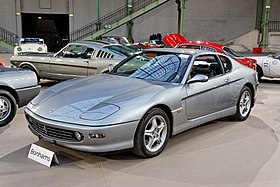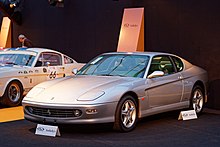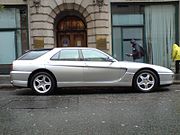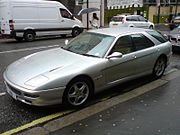
The Ferrari Testarossa is a 12-cylinder mid-engine sports car manufactured by Ferrari, which went into production in 1984 as the successor to the Ferrari Berlinetta Boxer. The Pininfarina-designed car was originally produced from 1984 until 1991, with two model revisions following the end of Testarossa production called the 512 TR and F512 M, which were produced from 1992 until 1996. Including revised variations, almost 10,000 cars in total were produced, making it at the time one of the most mass-produced Ferrari models.
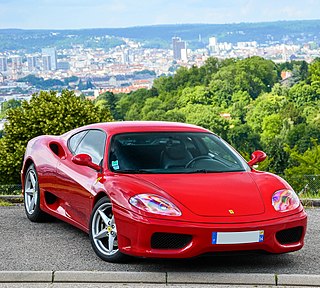
The Ferrari 360 is a two-seater, mid-engine, rear wheel drive sports car manufactured by Italian automotive manufacturer Ferrari from 1999 until 2005. It succeeded the Ferrari F355 and was replaced by the Ferrari F430 in 2004.
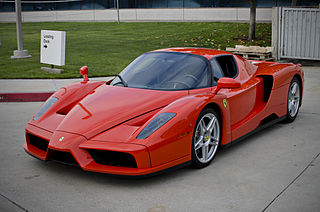
The Ferrari Enzo, officially marketed as Enzo Ferrari, is a mid-engine sports car manufactured by Italian automobile manufacturer Ferrari and named after the company's founder, Enzo Ferrari. It was developed in 2002 using Formula One technology, such as a carbon-fibre body, F1-style automated-shift manual transmission, and carbon fibre-reinforced silicon carbide (C/SiC) ceramic composite disc brakes, as well as technologies not allowed in F1, such as active aerodynamics. The Enzo generates substantial amounts of downforce through its front underbody flaps, small adjustable rear spoiler and rear diffuser, which work in conjunction to produce 343 kilograms (756 lb) of downforce at 200 km/h (124 mph) and 775 kilograms (1,709 lb) of downforce at 300 km/h (186 mph), before decreasing to 585 kilograms (1,290 lb) at top speed.

The Ferrari 575M Maranello is a two-seat, two-door, grand tourer manufactured by Italian automobile manufacturer Ferrari. Launched in 2002, it is essentially an updated 550 Maranello featuring minor styling changes from Pininfarina. The 575M was replaced by the 599 GTB in the first half of 2006.

The Ferrari 612 Scaglietti is an executive 2+2 coupé grand tourer manufactured by the Italian automobile manufacturer Ferrari between 2004 and 2010. It was designed to replace the smaller 456; its larger size makes it a true 4-seater with adequate space in the rear seats for adults.

The Ferrari F50 is a mid-engine sports car manufactured by Italian automobile manufacturer Ferrari from 1995 until 1997. Introduced in 1995, the car is a two-door, two seat targa top. The F50 is powered by a 4.7 L naturally aspirated Tipo F130B 60-valve V12 engine that was developed from the 3.5 L V12 used in the 1990 Ferrari 641 Formula One car. The car's design is an evolution of the 1989 Ferrari Mythos concept car.

The Bugatti EB 110 is a mid-engine sports car produced by Bugatti Automobili S.p.A. from 1991 until 1995, when the company was liquidated. A small number of post-production cars were completed afterwards, with the last one built by Dauer in 2002 and another unfinished example completed in 2019. It was the only production model made by Romano Artioli's Italian incarnation of Bugatti.

The Ferrari F430 is a sports car produced by the Italian automobile manufacturer Ferrari from 2004 until 2009 as a successor to the Ferrari 360. The car is an update to the 360 with exterior and performance changes. It was unveiled at the 2004 Paris Motor Show. The F430 was succeeded by the 458 which was unveiled on 28 July 2009.

The Ferrari F355 is a sports car manufactured by Italian car manufacturer Ferrari produced from May 1994 until 1999. The car is a heavily revised Ferrari 348 with notable exterior and performance changes. The F355 was succeeded by the all-new Ferrari 360 in 1999.

The Ferrari 275 is a series of front-engined V12-powered grand touring automobiles with two-seater coupé and spider bodies produced by Ferrari between 1964 and 1968. The first 275 series cars were powered by a 3.3 L (3286 cc) overhead camshaft Colombo 60° V12 engine producing 260–320 hp (190–240 kW). An updated 275 GTB/4 was introduced in 1966, with a revised four overhead camshaft engine producing 300 hp (220 kW). The 275 series were the first road-going Ferraris equipped with a transaxle and independent rear suspension.

The Ferrari Daytona is a two-seat grand tourer produced by Ferrari from 1968 to 1973. It was introduced at the Paris Auto Salon in 1968 to replace the 275 GTB/4, and featured the 275's Colombo V12 bored-out to 4,390 cc. It was offered in berlinetta and spyder forms. The car came in two variants: the 365 GTB/4 coupe, and the 365 GTS/4 convertible.

The Ferrari 365 GT4 2+2, Ferrari 400 and Ferrari 412 are front-engined V12 2+2 grand tourers made by Italian manufacturer Ferrari between 1972 and 1989. The three cars are closely related, using the same body, chassis and engine evolved over time.

The Ferrari 550 Maranello is a front-engine V12 2-seat grand tourer built by Ferrari from 1996 to 2002. The 550 Maranello marked Ferrari's return to a front-engine, rear-wheel drive layout for its 2-seater 12-cylinder model, 23 years after the 365 GTB/4 Daytona had been replaced by the mid-engined Berlinetta Boxer.

The Ferrari 599 GTB Fiorano is a grand tourer produced by the Italian automobile manufacturer Ferrari. It served as the brand's front-engined, two-seat model, replacing the 575M Maranello in 2006 as a 2007 model, and was later replaced for the 2013 model year by the F12berlinetta.

The Ruf BTR is a sports car built by German automobile manufacturer Ruf Automobile. The BTR began production in 1983 and was based on the Porsche 911 available in a narrow 911 or optional wide body configuration akin to the 930 Turbo. The BTR was the first Ruf production sports car with a company specific VIN.

The Ferrari 458 Italia is an Italian mid-engine sports car produced by Ferrari. The 458 is the successor of the F430, and was first officially unveiled at the 2009 Frankfurt Motor Show. It was succeeded by the 488 GTB in 2015.

The Ferrari 250 GT Berlinetta Lusso is a GT car which was manufactured by Italian automaker Ferrari from 1962 to 1964. Sometimes known as the GTL, GT/L or just Lusso, it is larger and more luxurious than the 250 GT Berlinetta. The 250 GT Lusso, which was not intended to compete in sports car racing, is considered to be one of the most elegant Ferraris.

The Ferrari F12berlinetta is a front mid-engine, rear-wheel-drive grand tourer produced by Italian automobile manufacturer Ferrari. The F12berlinetta debuted at the 2012 Geneva Motor Show, and replaced the 599 grand tourer. The naturally aspirated 6.3 litre Ferrari V12 engine used in the F12berlinetta has won the 2013 International Engine of the Year Award in the Best Performance category and Best Engine above 4.0 litres. The F12berlinetta was named "The Supercar of the Year 2012" by car magazine Top Gear. The F12berlinetta was replaced by the 812 Superfast in early 2017.

The Dino 206 GT, 246 GT and 246 GTS are V6 mid-engined sports cars produced by Ferrari and sold under the Dino marque between 1967 and 1974.

The Ferrari 812 Superfast is a front mid-engine, rear-wheel-drive grand tourer produced by the Italian sports car manufacturer Ferrari that made its debut at the 2017 Geneva Motor Show. The 812 Superfast is the successor to the F12berlinetta.
